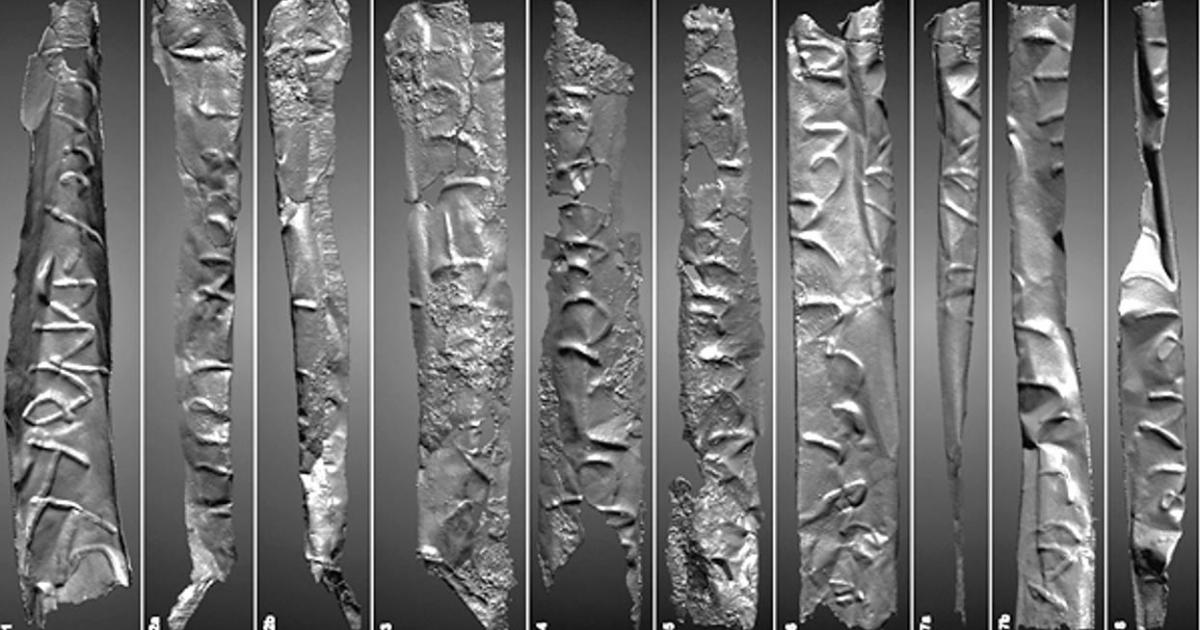
Magical Incantation Discovered on Ancient Silver Scroll Written in Unknown Language
We may never know what the magic spell says, but scholars using a CT scanner and new software have revealed an inscription or incantation on a tiny, tightly rolled silver scroll that was written about 1,300 years ago in Jordan.
The spell appears to have been written by a magician of unknown religion, but it is in a language he made up or some unknown language, says an article in the journal Nature. The authors call the language pseudo-Arabic and say Greek-based letters and magical symbols were also inscribed on the scroll. Both Muslims and Christians spoke Arabic in Jordan in the eighth century AD.
The practice of hammering out thin layers of gold, silver, lead or alloys and inscribing incantations on them was common in the Classical world, the paper says. Magicians also put their spells on papyri, which can be unfurled and read. The metal scrolls, though, cannot be unrolled without damaging them so much that they become illegible.
“The scroll was inscribed with 17 lines in presumed pseudo-Arabic as well as some magical signs,” says the paper, by Gry Hoffman Barfod and three other scholars. “The successful unfolding shows that it is possible to digitally unfold complexly folded scrolls, but that it requires a combination of the know-how of the software and linguistic knowledge.”
The metal documents were never meant to be read but rather after being rolled up, placed in amulets and then on a body or around the house as an apotropaic artifact meant to ward away evil or bad luck.

A side view of the silver sheet upon which the presumed spell was inscribed (Nature photo)
“This practice was longstanding in the Classical world and was an established way in which uncertainties of daily life were dealt with, including cases of illness, unrequited love and as protection against the evil eye, just to mention a few,” the paper states. “Such texts therefore let individuals speak directly to us through a medium and they give vivid insight into ancient mentalities and emotions, an insight which we hardly get from other literary or official ancient texts such as historiography, poetry or inscriptions.”
In the book Ancient Christian Magic: Coptic Texts of Ritual Power there are listed many different types of spells from a few hundred years later in Egypt. While the time and place of the Coptic spells differ from this scroll found in Jordan, the book gives a flavor of some of the types of spells people were making in the medieval world. Spells in the book include love charms; warding away of dangerous or dead people, disease or demons; protection against women’s or childbearing aliments; protection of children; and protections against dangerous animals, including crocodiles, snakes, or scorpions.
Some of the specific spells included in the book are:
- Amulet to heal eye ailments
- Amulet for help from god and the saints
- Amulet to protect against the mischief of evil spirits
- Spell for ascending through the heavens
- Invocation of the sun for protection
- Spell for protection against violent attack
- Erotic spell to attract a woman
- Spells for favor, honor and passion
- Spell to make a woman become pregnant
- Spell for a man to obtain a male lover
- Curse against several violent people
- Curse against perjurers
- Spell invoking a thundering power to perform every wish
- Spell of summons, by the power of god’s tattoos
- Curse against a woman’s face or work
- Bone curse to bring the powers of darkness down upon Aaron
- Three sexual curses to leave a man impotent and protect a woman from sexual advances

The ancient city of Jerash was unoccupied after the earthquake that destroyed the house in which the silver scroll was found but later was inhabited again and still is. These columns are among the ancient city’s ruins. (Photo by Ted Chi/Wikimedia Commons)
The researchers have included their methodology in the Nature article so others can digitally “unfurl” the ancient spells and reveal their contents, which would give, as they say, vivid insight into the ancient mind. They used new imaging software to reveal the archaic document.
Archaeologists found the amulet with the scroll in 2014 during excavations of a private house dating to 749 BC that an earthquake destroyed. The archaeologists found coins, pottery, glass bottles, jewelry and the scroll, which is only 0.15 millimeters thick, 42 mm long and has a diameter of 8 mm.
The researchers carefully extracted the scroll from the lead container after cleaning and restoring it.
“Since it was not possible to read the ‘text’ we cannot identify the religious affiliation of the amulet’s owner,” the authors wrote. “Such pseudo-scripts and letter-like magical signs are furthermore important evidence for literacy or non-literacy in the ancient world and the value and power written texts had for people.”
Featured image: This silver scroll, revealed digitally by a group of researchers, may be an incantation of an 8 th century magician in Jordan. The language is unknown, but the practice of placing magical incantations on scrolls and placing them in containers is well known from antiquity. (Nature photo)
By: Mark Miller
















Comments
I would think the correct amount of heat applied to any metal object would allow it to bend or unfold easily, no?
This is really a cool find. Because it is in the neighborhood of Babylon and the Sumerian empire. doing casting requires a mold. I wonder if the original mold was a standard concave cuneiform style, that when casted in silver the silver piece became convex lettering.
Troy Mobley
This could be nothing more than a Honey to do list.
IF it is Unreadable and UN-cypherable, HOW do you know that it is a spell? It could be the local recipe for camel urine and milk?
https://www.google.com/search?q=man+arrested+for+selling+fake+camel+urine